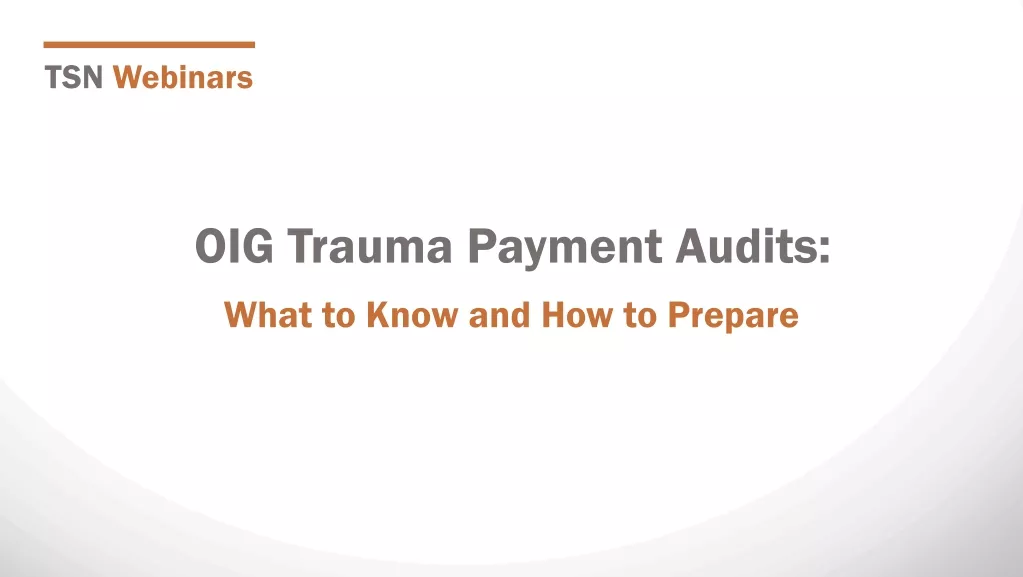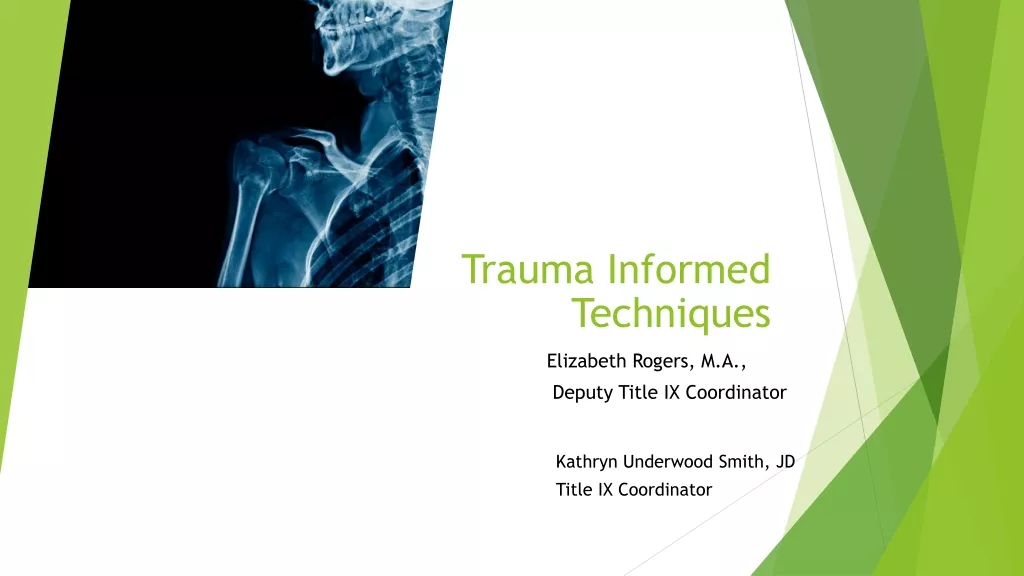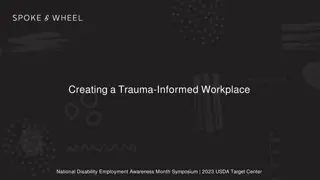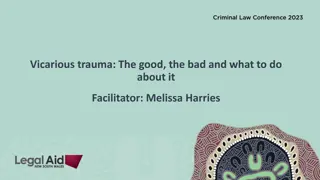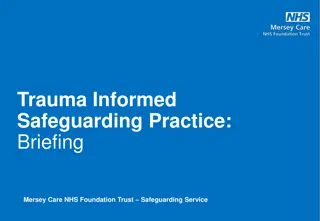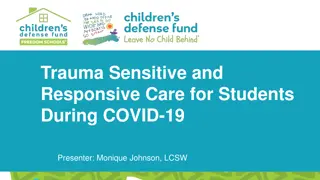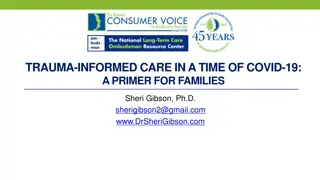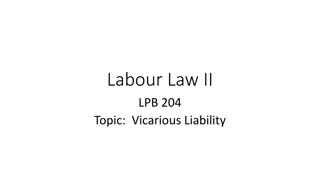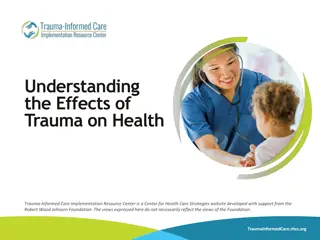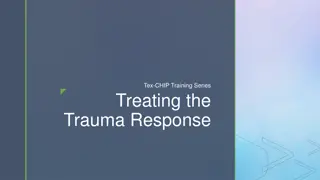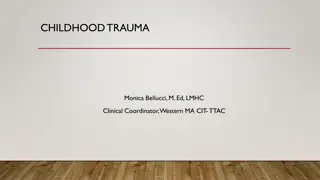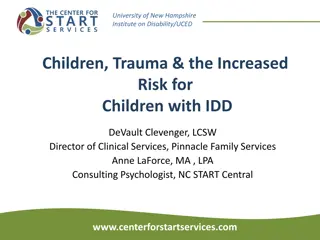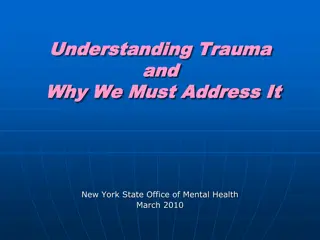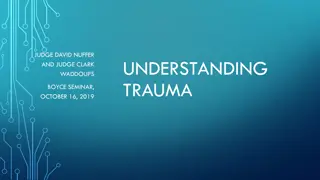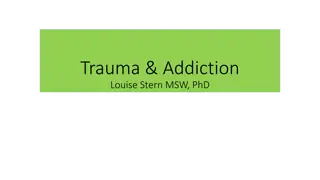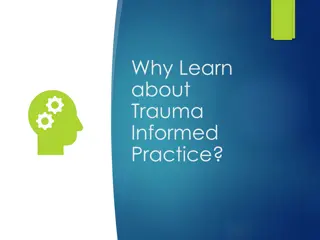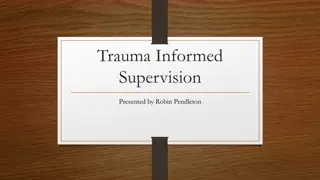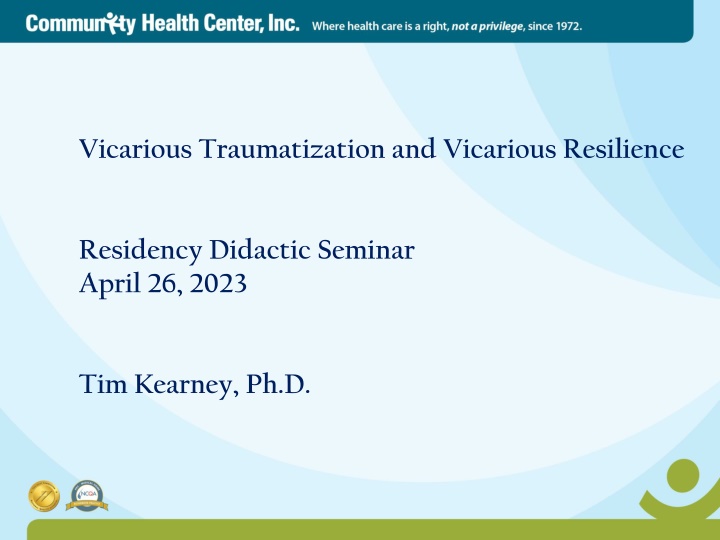
Vicarious Traumatization and Resilience in Mental Health Field
Explore the concepts of vicarious traumatization, resilience, burnout, compassion fatigue, and secondary traumatic stress in the mental health field. Learn about risk factors, symptoms, and strategies for coping with the emotional toll of caregiving. Join the seminar on April 26, 2023, led by Dr. Tim Kearney to deepen your understanding and build resilience.
Download Presentation

Please find below an Image/Link to download the presentation.
The content on the website is provided AS IS for your information and personal use only. It may not be sold, licensed, or shared on other websites without obtaining consent from the author. If you encounter any issues during the download, it is possible that the publisher has removed the file from their server.
You are allowed to download the files provided on this website for personal or commercial use, subject to the condition that they are used lawfully. All files are the property of their respective owners.
The content on the website is provided AS IS for your information and personal use only. It may not be sold, licensed, or shared on other websites without obtaining consent from the author.
E N D
Presentation Transcript
Vicarious Traumatization and Vicarious Resilience Residency Didactic Seminar April 26, 2023 Tim Kearney, Ph.D.
Objectives 1. Discuss recent (2023) National Council of Mental Wellbeing poll. 2. Define common terms in the area of empathic distress. 3. Consider risk factors, signs and symptoms, and impact of vicarious trauma. 4. Complete and discuss PROQOL 00/00/00 2
State of the BH field: National Council survey 2023 00/00/00 3
State of the field 00/00/00 4
State of the field 00/00/00 5
00/00/00 6
00/00/00 7
00/00/00 8
Burnout Most widely used of the four terms because anyone working in any field or job can experience it Burnout is a complex issue resulting from chronic work place stress (SAMHSA, 2022) Contributing factors: unrealistic expectations of workers, excessive workloads, lack of support Results may include: feeling depressed, overwhelmed, exhausted, detached, and ineffective at work. 00/00/00 9
Compassion Fatigue Unique form of burnout among caregivers. Carla Johnson, a nurse, introduced term in 1992: CF shares signs and symptoms of burnout but also adds the loss of the ability to nurture . Describes the impact of helping others vs burnout which focuses more on the work environment. 4 stages (HappyMD.com) Zealot: enthusiastic, go extra mile, committed to make a difference Irritability: sometimes avoid contact with pts, cut corners, lose focus Withdrawal: enthusiasm fails, exhaustion, irritated by patients, noticed Zombie: disdain, hostility, blaming pts, hopelessness, anger 00/00/00 10
Secondary Traumatic Stress Care provider experiences a stress reaction after witnessing or learning about trauma or adversity experienced by a client Typically quick in onset when speaking with client or shortly afterwards (Rauvola, et.al, 2019) Analogous to Acute Stress Disorder 00/00/00 11
Vicarious Trauma Cumulative version of Secondary Traumatic Stress Care provider develops, over time, negative changes in their own worldview after witnessing or learning about trauma experienced by clients Example: someone who works with young adults who have experienced trauma may come to belief the world is unsafe for children and this may impact how they parent their own children. Analogous to PTSD 00/00/00 12
Empathic Stress Recent literature switching the focus to looking at how individuals respond to trauma or other adversity among those served. Response varies by capacity for self-other differentiation Empathy: feeling with another person Empathic distress Self centered Negative feelings Desire to withdraw Compassion Other centered Positive feelings Desire to help 00/00/00 13
Advantages to Empathic Stress perspective Empathy not compassion as starting point for stress experiences Stress experiences seen as unhealthy response to trauma or adversity experienced by another person The term compassion is reserved for the more rewarding pathway of compassion satisfaction May feel less judgmental to provider Actionable concept providers can be trained and supported 00/00/00 14
Risk Factors In the Provider Personality/Coping Style Professional Role Personal History Life Circumstances Social Support Spiritual Resources Work style In the Situation In the Cultural Context Cultural Intolerance Distress/Support Culture of providers Agency Support Client response 00/00/00 15
Signs and Symptoms Changes in Worldview or Frame of Reference Changes in Spirituality Changes in Identity Changes in believes related to major psychological needs Physical and Psychological Changes Hyperarousal (nightmares, sleep difficulties, increased startle reflex) Intrusive thoughts or images re clients trauma Feel numb Unable to tolerate strong emotions Cynicism Generalized despair and hopelessness Guilt regarding your own good fortune or pleasures 00/00/00 16
Signs and Symptoms Behavioral and Relationship Signs Difficulty setting boundaries and separating work and personal life Feeling like you never have time or energy for yourself Feeling disconnected from loved ones even when with them Increased conflict in relationships Decreased interest in thinks that used to give you pleasure Irritable, intolerant, agitated, impatient, needy, and/or moody Increased dependencies or addictions involving nicotine, alcohol, food, sex, shopping, internet, and/or other substances Sexual difficulties Impulsivity 00/00/00 17
Impact On family and friends Struggles can have major impact on family and friends. Consider asking people who are close to you: What have you noticed about the way I behave or appear to feel when under pressure? In what ways do you think my work has impacted me in the past week/month/year? From your point of view, how does this most impact you or others you care about? On work: Make decisions without reflection Take on too much work Not fulfill commitments Take excessive unplanned time off 00/00/00 18
Impact On work (continued) Blame others rather than seek understanding and collaboration Infect colleagues with their own cynicism, depression or lack of motivation 00/00/00 19
What helps Coping with Vicarious Trauma: learning to live with this as a part of our job Identify strategies that help prevent VT from becoming severe and Help manage it when it is problematic Escape Rest Play Transforming Vicarious Trauma: recognizing challenges of the work and identifying ways to nurture a sense of meaning and hope Remind yourself of the importance of the work we do Stay connected with family, friends, and colleagues Mark transitions, celebrate joys, mourn losses Take time to reflect 00/00/00 20
ABCs to prevent, reduce, and recover Awareness: Balance: Connection: Check in with yourself regularly Potential risk factors to which you are exposed How are you responding? Work/life balance Balancing work demands Connecting with other people Spiritual connection 00/00/00 21
Vicarious Resilience The positive impact on helping professionals of seeing clients work to overcome the impact of traumatic experiences on their lives. Possible results for helping professionals: Changes in life goals and perspective Client inspired hope Increased recognition of clients spirituality as a resource Increased capacity for resourcefulness Increased self-awareness and self care practices Increased consciousness of power and privilege relative to clients Increased capacity for remaining present while listening to clients trauma narratives 00/00/00 22
Professional Quality of Life Scale (PROQOL) Professional Quality of Life Compassion Satisfaction Compassion Fatigue Burnout Secondary Traumatic Stress ProQOL Measure | ProQOL 00/00/00
References 00/00/00 24
00/00/00 25
00/00/00 26
00/00/00 27
00/00/00 28

